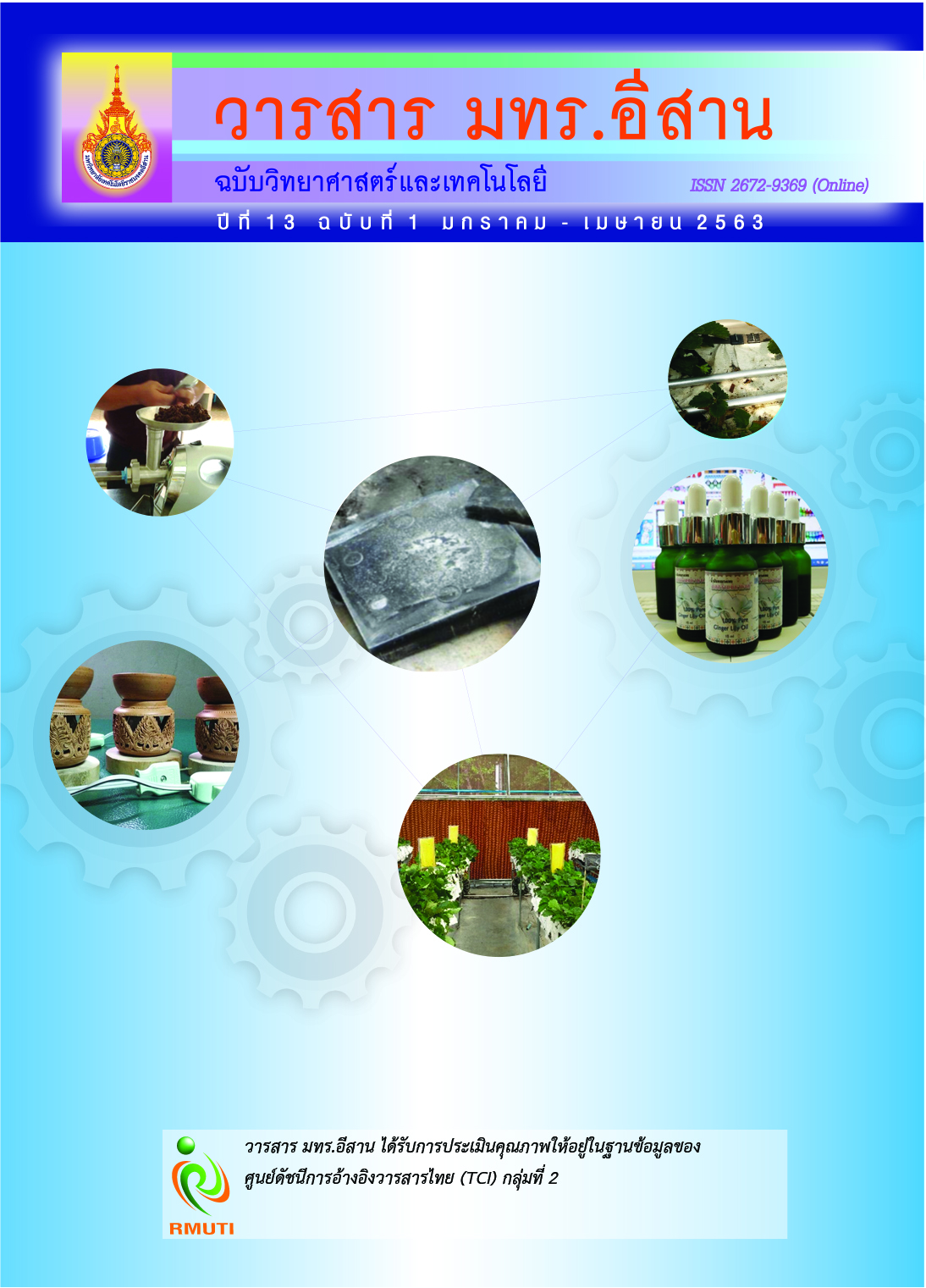Phytochemicals Screening and Antifungal Activity Against Colletotrichum capsici of Wood Vinegar from Garcinia mangostana Fruit
Main Article Content
Abstract
The objective of this research studied the effect of time storage on the physical properties, phytochemical and antifungal activity againts Colletotrichum capsici of wood vinegar from poor quality mangosteen fruit. Two types of wood vinegar; collected from the dehydration step (part 1) and the carbonization step (part 2) were used for this study. The results showed that the physical properties; pH, boiling point and density of both vinegar were found in ranges of 4.98 - 5.10, 105 - 113 oC and 0.9738 - 1.0071 g/cm3, respectively. The chemical constituents screening of these two vinegar also presented the same class of phytochemicals; alkaloids, phenolic compounds and terpenoids. The storage time of two types of wood vinegar for 2, 3, 4 and 6 months at room temperature did significantly effect on the physical properties (P0.05) but effect neither on the group of phytochemicals. For antifungal activity assay, the 4 months storing wood vinegar obtained from carbonization step exhibited the highest antifungal activity against C. capsici respect to the IC50 of 7.67 %w/v when compared to that obtained from the dehydration step (IC50 15.19 %w/v). However, the antifungal activity of these wood vinegar from mangosteen fruits against C. capsici were less than Carbendazim (IC50 0.64 %w/v).
Article Details
References
Payamara, J. (2011). Usage of Wood Vinegar as New Organic Substance. International Journal of ChemTech Research CODEN (USA): IJCRGG. Vol. 3, No. 3, pp. 1658-1662
Baimark, Y. andNiamsa, N. (2009). Study on Wood Vinegars for Use as Coagulatingand Antifungal Agents on the Production of Natural Rubber Sheets. Biomass and Bioenergy. Vol. 33, No. 6/7, pp. 994-998. DOI: 10.1016/j.biombioe.2009.04.001
Yahayu, M., Mahmuda, K. N., Mahamada, M. N., Ngadirana, S., Lipehb, S., Ujangb, S. and Zakariaa, Z. A. (2017). Efficacy of Pyroligeneous Acid from Pineapple Waste Biomass as Wood Preserving Agent. Journal Teknologi (Sciences & Engineering). Vol. 79, No. 4, pp. 1-8
Wang, H. F., Wang, J. L., Wang, C., Zhang, W. M., Liu, J. X., and Dai, B. (2012). Effect of Bamboo Vinegar as An Antibiotic Alternative on Growth Performance and Fecal Bacterial Communities of Weaned Piglets. Livestock Science. Vol. 144, Issue 1-2, pp. 173-180. DOI: 10.1016/j.livsci.2011.11.015
Nakai, T., Kartal, N., Hata, T., and Imamura, Y. (2007). Chemical Characterization of Pyrolysis Liquids of Wood-Based Composites and Evaluation of Their Bio-efficiency. Building and Environment. Vol. 42, Issue 3, pp. 1236-1241. DOI: 10.1016/j.buildenv.2005.11.022
Kang, H. C., Park, Y. H., and Go, S. J. (2003). Growth Inhibition of A Phytopathogenic Fungus, Colletotrichum Species by Acetic Acid. Microbiological Research. Vol. 158, Issue 4, pp. 321-326. DOI: 10.1078/0944-5013-00211
Sangnak, V. and Nalumpang, S. (2010). Efficiency of Wood Vinegar Extracts from Eucalyptus and Neem Trees for Controlling Collectotrichum gloeosporioides. Journal of Agriculture. Vol. 26, No. 3, pp. 213-222 (in Thai)
Prasothong, N., Plainsirichai, M., Bussaman, P., Luckantinvong, V., and Wongsawas, M. (2011). Effect of Mangosteen (Garcinia mangostana L.) Peel Extract on Anthracnose Disease (Colletotrichum gloeosporioides Penz.) of Mango Fruit cv. In Proceeding of the 7th Agricultural Systematic National Conference. Maha Sarakham, Thailand. pp. 520-525 (in Thai)
Farnsworth, N. R. (1996). Biological and Phytochemical Screening of Plants. Journal of Pharmaceutical Sciences. Vol. 55, Issue 3, pp. 225-276. DOI: 10.1002/jps.2600550302
Ayoola, G. A., Coker, H. A. B., Adesegun, S. A., Adepoju-Bello, A. A., Obaweya, K., Ezennia, E. C., and Atangbayila, T. O. (2008). Phytochemical Screening and Antioxidant Activities of Some Selected Medicinal Plants Used for Malaria Therapy in Southwestern Nigeria. Tropical Journal of Pharmaceutical Research. Vol. 7, No. 3, pp. 1019-1024. DOI: 10.4314/tjpr.v7i3.14686
Bussaman, P., Namsena, P., Rattanasena, P. and Chandrapatya. A. (2012). Effect of Crude Leaf Extract on Colletotrichum gleosporioides (Penz.) Sacc. Psyche: A Journal of Entomology. Vol. 2012, pp. 1-6. DOI: 10.1155/2012/309046
Chaichompoo, W. and Phichai, K. (2010). Effect of Plant Extract on Growth Inhibition of Colletotrichumsp. Rajamangala University of Technology Tawan-ok Research Journal. Vol. 3, No. 2, pp. 18-25 (in Thai)
Hiranrat, A., Wongsawat, P., Hiranrat, W., and Sumanatrakul, P. (2013). Investigation of Antioxidation Properties from the Wood Vinegar of Mangosteen Fruits. Thaksin University Journal. Vol. 16, No. 3, pp. 120-130 (in Thai)
Thai Community Product Standards. (2010). Wood Charcoal Vinegar 659/2553. Thai Industrial Standards Institute, Ratchathewi, Bangkok. pp. 1-3 (in Thai)
Luenam, L. (2013). Research of Charcoal Stove and Wood Vinegar Production from Mangoteen Peel. In The 14th TSAE National Conference and the 6th TSAE International Conference: TSAE 2013. Hua Hin, Thailand, pp. 428-431 (in Thai)
Onthong, U., Thongnueakhaeng, W., and Mekjinda, N. (2015). The Efficiency of Wood Vinegar from The Mangoteen Peel for The Rubber Sheets Production. Thaksin University Journal. Vol. 18, No. 3, pp. 154-160 (in Thai)
Jung, H. A., Su, B. N., Keller, W. J., Mehta, R. G., and Kinghorn, A. D. (2006). Antioxidant Xanthones from The Pericarp of Garcinia mangostana (Mangosteen). Journal of Agricultural and Food Chemistry. Vol. 54, No. 6, pp. 2077-2082. DOI: 10.1021/jf052649z
Peres, V., Nagem, T. J., and Olivera, F. F. (2000). Tetraoxygenated Naturally Occurring Xanthones. Phytochemistry. Vol. 55, Issue 7, pp. 683-710. DOI: 10.1016/s0031-9422(00)00303-4
Manimekalai, I., Sivakumari, K., Ashok, K., and Rajesh, S. (2016). Phytochemical Profiling of Mangoteen Fruit, Garcinia mangostana. World Journal of Pharmacy and Pharmaceutical Sciences. Vol. 5, Issue 2, pp. 221-252
Obolskiy, D., Pischel, I., Siriwatanametanon, N., and Heinrich, M. (2009). Garcinia mangostana L.: A Phytochemical and Pharmacological Review. Phytotherapy Research. Vol. 23, Issue 8, pp. 1047-1065. DOI: 10.1002/ptr.2730
Chaaban, H., Ioannou, I., Chebil, L., Slimane, M., Gérardin, C., Paris, C., and Ghoul, M. (2017). Effect of Heat Processing on Thermal Stability and Antioxidant Activity of Six Flavonoids. Journal of Food Processing and Preservation. Vol. 41, Issue 5, pp. 1-12. DOI: 10.1111/jfpp.13203
Theapparat, Y., Chandumpai, A., and Faroongsarng, D. (2017). Physicochemistry and Utilization of Wood Vinegar from Carbonization of Tropical Biomass Waste. Tropical Forests-New Edition. Intech Open, pp. 163-183. DOI:10.5772/intechopen.77380
Wisittawong, N. and Nalumpang, S. (2017). Controlling Penicillium Fruit Rot of Citrus Using Wood Vinegar and Some Medicinal Plant Extracts. Thai Agricultural Research Journal. Vol. 35, No. 1, pp. 100-109 (in Thai)


